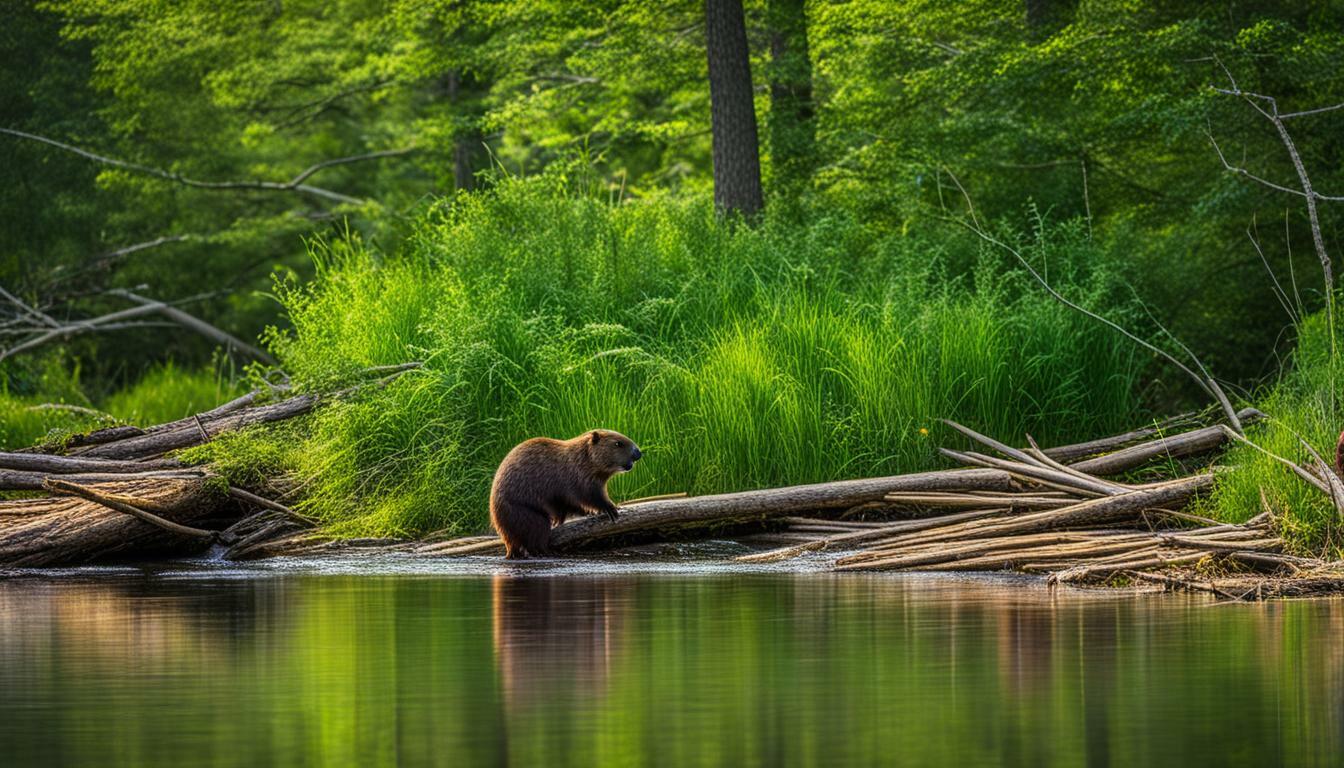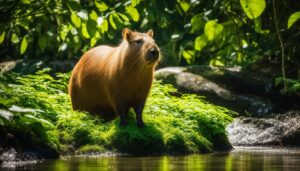Beavers are a fascinating part of Wisconsin’s wildlife, but are they actually present in the Badger State? Let’s explore the beaver population in Wisconsin and their impact on the local ecosystem.
Key Takeaways:
- Beavers are indeed present in Wisconsin.
- Their population can be found in various locations throughout the state.
- Beavers have been a subject of discussion due to their impact on trout populations and habitat restoration projects.
- The Department of Natural Resources (DNR) works to create ideal trout habitat, attracting beavers to the area.
- Beaver culling has been carried out by the DNR and other agencies to prevent flooding, especially on private lands.
The Beaver Population in Wisconsin
Wisconsin boasts a diverse wildlife population, including a significant presence of beavers in various habitats. These industrious creatures can be found throughout the state, thriving in rivers, lakes, and wetlands. Beavers are known for their remarkable ability to create and modify their habitats, building dams and lodges that serve as their homes. They are essential contributors to the natural ecosystem, playing a crucial role in maintaining the balance of Wisconsin’s wildlife.
Beaver Facts in Wisconsin
Beavers in Wisconsin are well-adapted to their environment, with webbed hind feet and a distinct flat tail that helps them swim efficiently and construct their impressive dams. Their dams serve multiple purposes, from creating deep ponds that provide protection against predators to altering water flow, thus creating wetland habitats that support a variety of plants and other wildlife.
One interesting fact about beavers is that they are herbivores, primarily feeding on the bark, leaves, and twigs of trees and shrubs. Their teeth grow continuously, enabling them to gnaw through tough materials like wood. Their feeding habits make them vital contributors to the health and regeneration of forest ecosystems.
The Impact of Beavers on Habitat Restoration
While beavers are a valuable part of Wisconsin’s wildlife, their activities can sometimes conflict with human efforts to restore habitats, particularly in areas where trout populations are a conservation focus. The construction of beaver dams can alter stream flow, potentially impacting the habitat requirements of trout. This has led to ongoing research to better understand the relationship between beavers, trout populations, and habitat restoration efforts.
| Beaver Population | Trout Populations | Habitat Restoration Efforts |
|---|---|---|
| Thriving in various habitats across Wisconsin | Impacted by beaver dam construction | Continual research and management to balance beaver and trout needs |
The Department of Natural Resources (DNR) is actively involved in creating ideal trout habitat while managing the beaver population’s impact. By striking a balance between the needs of both species, the DNR aims to ensure the continued health and sustainability of Wisconsin’s ecosystem.
Furthermore, beavers have been known to return to urban areas like Milwaukee, showcasing their adaptability and resilience. Their presence serves as a positive indicator of environmental recovery and cleanup efforts. Observing beavers flourishing in urban settings reminds us of the importance of preserving and protecting our natural landscapes.
Impact on Trout Populations and Habitat Restoration
The beaver population in Wisconsin has raised concerns due to their effect on trout populations and ongoing habitat restoration projects. Beavers, while native to the state, have the ability to drastically alter their surrounding environments through their dam-building activities. While these dams can create suitable habitats for beavers, they can also have unintended consequences for other species, such as trout.
Trout populations rely on clean and well-oxygenated water, and beaver dams can disrupt the natural flow of streams and rivers. The buildup of debris and sediments behind these dams can affect the water quality and hinder trout from successfully reproducing. Additionally, the dams can create barriers that prevent trout from accessing their preferred spawning grounds.
Efforts to restore trout habitats in Wisconsin often involve the removal or modification of beaver dams. The Department of Natural Resources (DNR) works diligently to create ideal trout habitat, implementing structures that mimic natural stream conditions. These efforts can attract beavers, as they are naturally drawn to areas with available food and suitable water sources. However, the dams built by beavers can undo the DNR’s hard work and lead to flooding, particularly on private lands.
| Effect of Beaver Dams on Trout Populations: | |
|---|---|
| Disrupts natural flow of streams and rivers | ✓ |
| Impacts water quality and oxygen levels | ✓ |
| Creates barriers to trout migration | ✓ |
To manage the beaver population and mitigate potential flooding, the DNR and other agencies have implemented beaver culling practices. This involves the removal of beavers from certain areas, particularly on private lands where flooding can cause damage to property. However, this practice is not without controversy.
Conservationist Perspective
Some conservationists argue that beavers play a vital role in stabilizing stream temperatures and reconnecting rivers and streams to their natural floodplains. They see the beaver’s dam-building activities as beneficial for overall ecosystem health and resilience. They advocate for a more holistic approach, one that considers the long-term benefits of having beavers in the landscape.
Research is ongoing to better understand the impact of beaver dams on local trout populations and habitat restoration efforts. Scientists are studying how different management practices, such as dam modifications and flow control, can help strike a balance between supporting beaver populations and maintaining healthy trout habitats.
Furthermore, there have been sightings of beavers returning to urban areas like Milwaukee. Their presence in these locations is seen as a positive sign of ecosystem recovery and environmental cleanup. It highlights the resilience of beavers and their ability to adapt to changing landscapes.
The beaver population in Wisconsin continues to be a topic of interest and concern as the state strives to balance the needs of various species and maintain a healthy ecosystem. Ongoing research and collaboration between wildlife agencies and conservationists will contribute to a better understanding of the complex relationship between beavers, trout populations, and habitat restoration efforts.
Department of Natural Resources (DNR) Efforts
The Department of Natural Resources plays a crucial role in managing beaver populations and ensuring ideal trout habitat in Wisconsin. Recognizing the importance of these animals in the ecosystem, the DNR strives to strike a balance between the benefits and challenges that beavers bring.
To create ideal trout habitat, the DNR focuses on maintaining proper water flow and vegetation levels, which attract beavers to specific areas. However, the dam-building activities of beavers can sometimes hinder these efforts, leading to flooding and potential damage to property, particularly on private lands.
As a result, the DNR, along with other agencies, has implemented beaver culling measures. These targeted efforts aim to control beaver populations and mitigate the negative impacts of beaver dams. By carefully managing these ecosystems, the DNR aims to ensure the overall health and balance of the Wisconsin wilderness.
| Beaver Culling Measures: | Impact: |
|---|---|
| Targeted removal of beavers on private lands | Reduces the risk of flooding and property damage |
| Implementing water flow management techniques | Maintains proper water levels for trout habitat |
| Promoting vegetation control strategies | Prevents excessive vegetation growth caused by beaver activity |
While some may question the practice of beaver culling, conservationists argue that beavers have a vital role in stabilizing stream temperatures and reconnecting rivers and streams to their natural floodplains. This perspective challenges the traditional approach to managing beaver populations and highlights the ongoing debate surrounding their impact on trout habitats in Wisconsin.
Role of Beaver Management Plans
As part of their efforts, the DNR has implemented beaver management plans across Wisconsin. These plans aim to find a balance between managing beaver populations and preserving the ecosystem. By assessing the specific needs of each area, the DNR can tailor their management strategies to ensure the long-term viability of both beavers and trout populations.
Beaver Culling and Flooding
To prevent property damage caused by flooding, beaver culling has been carried out in Wisconsin, particularly in areas where beavers create dams. While beavers are native to the state and their activities can have ecological benefits, their dam-building tendencies can also cause issues for humans living in flood-prone areas.
When beavers build dams, they can create barriers that impede the natural flow of water. This can result in water backing up and flooding nearby lands, including private properties. Recognizing the need to manage the beaver population and prevent potential damage, the Department of Natural Resources (DNR) and other agencies have implemented beaver culling programs.
These culling efforts aim to control the number of beavers in specific areas where their dam building can lead to significant flooding problems. By removing or relocating beavers, authorities can minimize the risks associated with flooding, protecting both human property and infrastructure.
| Benefits of Beaver Culling | Concerns and Challenges |
|---|---|
|
|
Management Strategies
In addition to culling, alternative management strategies have emerged to address the challenges associated with beaver activities and flooding. These strategies focus on reducing the negative impacts while preserving the ecological benefits of beavers.
One approach is the use of flow devices, which are installed in beaver dams to regulate water flow and prevent flooding. These devices allow water to pass through while still allowing beavers to maintain their desired habitat. Habitat modification, such as creating deeper ponds or constructing artificial dams in less problematic areas, can also help mitigate flooding risks.
Ensuring a balance between human needs and the ecological benefits of beavers is an ongoing challenge. Continued research and collaboration between conservationists, government agencies, and local communities are crucial for effective beaver management, maintaining ecosystem health, and safeguarding against property damage caused by flooding.
Conservationist Perspective
Some conservationists argue that beavers play a vital role in ecosystem stability and should be allowed to thrive in Wisconsin. These industrious creatures are nature’s engineers, capable of transforming their surroundings with their dam-building activities. By constructing dams, beavers create wetland habitats that benefit a variety of other plant and animal species.
Beavers are adept at creating intricate water networks, which help restore natural floodplains. This reconnection of rivers and streams to their floodplains plays a crucial role in reducing the risk of flooding, especially during heavy rainfall. Additionally, beaver dams can help regulate water flow, replenish groundwater, and improve water quality by filtering sediments and pollutants.
Their presence also has a positive impact on stream temperatures. The shade provided by beaver ponds helps keep water cool, which is essential for the survival of sensitive fish species like trout. These cooler water temperatures create ideal conditions for trout reproduction and growth, contributing to the overall health of the aquatic ecosystem.
| Benefits of Beavers in Wisconsin: |
|---|
| Creation of wetland habitats |
| Restoration of natural floodplains |
| Regulation of water flow |
| Improvement of water quality |
| Maintenance of cooler stream temperatures |
While these contributions are significant, managing beaver populations can be a complex task. The Department of Natural Resources (DNR) and other agencies have implemented beaver culling initiatives, particularly on private lands where flooding poses risks to property. However, some conservationists argue that culling should be approached with caution, as it may disrupt the delicate balance that beavers bring to the ecosystem.
Continued research into the impact of beaver damming on trout populations is crucial for finding sustainable solutions that strike a balance between habitat restoration and flood prevention. As beavers make their return to urban areas like Milwaukee, their presence serves as a positive indicator of environmental recovery and the successful cleanup of waterways.
Research on Trout Populations
Extensive research is being conducted to gain a deeper understanding of how beaver dams influence the trout population in Wisconsin. The presence of beavers and their dam-building activities can have both positive and negative effects on trout habitats.
One of the primary impacts of beaver dams on trout populations is the creation of new habitat. Beavers construct dams by felling trees and building structures that create small ponds or reservoirs. These reservoirs provide slow-moving water that can serve as ideal spawning and rearing grounds for trout. The calm, deep pools created by beaver dams also offer protection from predators and fluctuating water temperatures, contributing to the overall health and survival rates of trout populations.
On the other hand, the presence of beaver dams can also have negative consequences for trout populations. One potential issue is reduced water flow. Beaver dams can slow down or redirect the flow of water, leading to stagnant areas or disrupting the natural flow patterns that trout rely on for migration and feeding. Additionally, beaver dams can cause localized flooding, which may inundate trout spawning areas and negatively impact the survival of young trout.
Researchers are working to determine the optimal number and placement of beaver dams to strike a balance between the benefits and drawbacks they provide for trout populations. By studying the behavior of beavers and monitoring trout populations in areas with and without beaver activity, scientists hope to develop strategies that support both healthy beaver populations and thriving trout habitats.
| Research Objectives | Methods | Expected Results |
|---|---|---|
| Assess the impact of beaver dams on trout populations | Monitoring of trout populations in areas with and without beaver activity | Identification of the positive and negative effects of beaver dams on trout habitats |
| Determine the optimal number and placement of beaver dams for trout habitat restoration | Observation of beaver behavior and their dam-building activities | Development of strategies to support both beaver populations and healthy trout habitats |
| Evaluate the long-term effects of beaver dam removal on trout populations | Comparative studies in areas where beaver dams were removed | Insight into the potential benefits or drawbacks of removing beaver dams for trout populations |
Beavers Returning to Urban Areas
Beavers have been observed making a comeback in urban areas, such as Milwaukee, which is seen as a positive sign of ecosystem recovery. These industrious creatures, known for their dam-building activities, have adapted to urban environments, finding suitable habitats in parks, riverbanks, and even vacant lots.
Their return to urban areas is a testament to the efforts made in recent years to clean up and restore natural habitats. As the health of rivers and streams improves, beavers are naturally drawn to these revitalized ecosystems, establishing their colonies and creating a ripple effect of positive change.
In urban areas, beavers play a crucial role in supporting local biodiversity. By constructing dams and altering water flow, they create diverse wetland habitats that attract a wide range of plant and animal species. Their presence helps to maintain healthy water levels, filter pollutants, and mitigate flooding, all of which contribute to ecological balance.
Reconnecting Urban Communities with Nature
Beavers also serve as environmental educators, offering a unique opportunity for urban residents to connect with nature. Their activities provide a visible and tangible reminder of the importance of preserving and restoring natural habitats in urban settings. Observing beavers in action can inspire individuals and communities to take further steps in environmental stewardship, such as participating in local conservation initiatives or advocating for the protection of green spaces.
| Benefits of Beavers in Urban Areas |
|---|
| 1. Restoration of wetland ecosystems |
| 2. Protection against flooding |
| 3. Enhancement of biodiversity |
| 4. Improvement of water quality |
As these resilient creatures continue to adapt and flourish in urban environments, their presence serves as a reminder of the importance of coexisting with nature and the benefits that can be reaped from allowing ecosystems to recover. By embracing and supporting the return of beavers to urban areas, we are taking a significant step towards creating a more sustainable and harmonious relationship with our natural surroundings.
Beavers and Ecosystem Balance
Beavers are an essential component of Wisconsin’s ecosystem, contributing to the overall balance of wildlife populations. These industrious creatures play a crucial role in shaping their environment and creating habitats that benefit numerous other species.
One of the most remarkable contributions of beavers is their ability to construct dams. By building these dams across streams and rivers, beavers create ponds that serve as valuable habitats for various aquatic plants and animals. These habitats support a diverse range of wildlife, including fish, amphibians, and waterfowl.
Furthermore, the presence of beaver dams helps in water retention, preventing excessive runoff and reducing the risk of erosion. These dams also play a crucial role in filtering sediment and pollutants, improving water quality not just for themselves but for other organisms downstream.
Beavers as Ecosystem Engineers
Beavers are true ecosystem engineers. Their dam-building activities create a complex network of wetlands, which act as ecological hotspots supporting a wealth of biodiversity. These wetlands provide essential breeding and foraging grounds for various species, including birds, mammals, and reptiles.
| Species | Role |
|---|---|
| Salmon and trout | Benefit from the flooded areas created by beaver dams during spawning season |
| Songbirds | Nest and forage in the surrounding vegetation |
| Plants | Thrive in the nutrient-rich soil generated by beaver activities |
It is important to recognize the significant role that beavers play in maintaining the ecosystem’s health and resilience. By creating diverse habitats and improving water quality, they contribute to the overall balance of Wisconsin’s wildlife populations.
Conclusion
Beavers are indeed present in Wisconsin and play a crucial role in the state’s ecosystems, despite the ongoing debate surrounding their management. These fascinating creatures are found in various locations throughout Wisconsin, contributing to the rich biodiversity of the region.
The beaver population in Wisconsin has been a topic of discussion, particularly due to their impact on trout populations and habitat restoration projects. The Department of Natural Resources (DNR) is actively involved in creating ideal trout habitat, which can attract beavers to the area. However, the dam-building activities of beavers can sometimes undo the habitat work carried out by the DNR, leading to potential flooding.
As a result, beaver culling has been implemented by the DNR and other agencies, especially on private lands where flooding can cause property damage. However, there is an ongoing debate about the practice, with some conservationists arguing that beavers play a vital role in stabilizing stream temperatures and reconnecting rivers and streams to their natural floodplains, thus challenging the need for culling.
Research is currently being conducted to better understand the impact of beaver dams on local trout populations in Wisconsin. These studies aim to provide valuable insights into the interactions between beavers and the ecosystem, contributing to more informed management strategies.
| Key Points: |
|---|
| Beavers are present in Wisconsin and contribute to the state’s ecosystems. |
| The beaver population has an impact on trout populations and habitat restoration. |
| The Department of Natural Resources (DNR) works to create ideal trout habitat but also carries out beaver culling to prevent flooding. |
| There is debate among conservationists regarding the practice of beaver culling and the role of beavers in ecosystem balance. |
| Ongoing research aims to better understand the impact of beaver dams on local trout populations. |
Conclusion
Beavers are fascinating creatures that have established themselves as an integral part of Wisconsin’s wildlife, and their presence continues to shape the state’s ecosystems. As native residents, beavers can be found in various locations throughout Wisconsin, contributing to the diversity and balance of the natural landscape. However, their impact on trout populations and habitat restoration projects has sparked discussion and led to intervention measures by the Department of Natural Resources (DNR) and other agencies.
The DNR works diligently to create ideal trout habitat, which can attract beavers to the area. While beavers play a significant role in stabilizing stream temperatures and reconnecting rivers and streams to their natural floodplains, their dam-building activities can sometimes undermine the DNR’s efforts. This can result in flooding, particularly on private lands where damage to property is a concern.
As a result, beaver culling has been carried out by the DNR and other agencies to control the population and mitigate flooding risks. However, this practice has been met with opposition from some conservationists who argue that beavers are essential for maintaining ecosystem balance. Ongoing research is being conducted to better understand the impact of beaver dams on local trout populations, further informing the management of beaver populations in Wisconsin.
In recent times, beavers have even been sighted returning to urban areas like Milwaukee. Their presence in such environments is seen as a positive sign of environmental recovery and efforts to clean up the ecosystem. These sightings highlight the resilience and adaptability of beavers, as well as their ability to thrive in both natural and developed landscapes.
All in all, beavers in Wisconsin hold a crucial place in the state’s ecological tapestry. Balancing their unique activities with habitat restoration projects and flood prevention efforts remains an ongoing challenge. As the understanding of their role continues to evolve through research and conservation efforts, the management of Wisconsin’s beaver population will continue to shape the future of the state’s ecosystems.
FAQ
Are beavers present in Wisconsin?
Yes, beavers are present in various locations throughout Wisconsin.
What is the beaver population in Wisconsin?
The beaver population in Wisconsin is significant, with these animals being native to the state.
What impact do beavers have on trout populations and habitat restoration?
Beavers can have both positive and negative impacts on trout populations and habitat restoration projects in Wisconsin.
What efforts are being made by the Department of Natural Resources (DNR) to manage beavers?
The DNR works to create ideal trout habitat and manage beaver populations in Wisconsin.
Why is beaver culling carried out in Wisconsin?
Beaver culling is carried out, particularly on private lands, to prevent flooding and protect property.
What is the conservationist perspective on beavers in Wisconsin?
Some conservationists argue that beavers play a vital role in stabilizing stream temperatures and reconnecting rivers and streams to their natural floodplains in Wisconsin.
What research is being conducted on the impact of beaver dams on trout populations?
Ongoing research aims to better understand the impact of beaver dams on local trout populations in Wisconsin.
Have beavers been spotted returning to urban areas in Wisconsin?
Yes, beavers have been spotted returning to urban areas like Milwaukee, which is seen as a sign of ecosystem recovery and environmental cleanup.
What is the role of beavers in maintaining ecosystem balance in Wisconsin?
Beavers play an important role in maintaining ecosystem balance and are considered an integral part of Wisconsin’s natural landscape.




